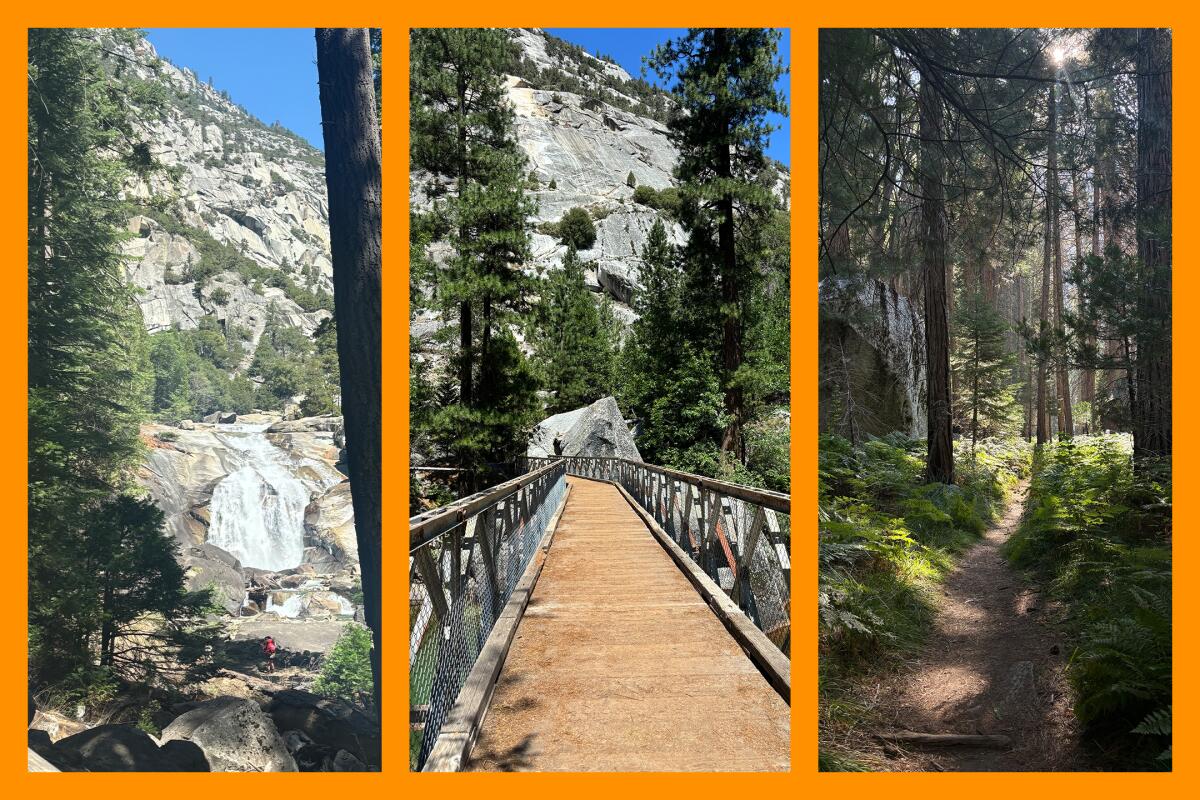Hiking in and around L.A. can often feel like its own mini-vacation. Our local public lands offer many different types of escape, whether you want to take a quick run through Griffith Park, a day hike with ocean views, or a backpacking adventure through Angeles National Forest.
But sometimes, you need an actual escape. And for that, friends, I recommend driving five hours north to Kings Canyon National Park.
Newsletter
You are reading The Wild newsletter
Sign up to get expert tips on the best of Southern California’s beaches, trails, parks, deserts, forests and mountains in your inbox every Thursday
You may occasionally receive promotional content from the Los Angeles Times.
Sequoia and Kings Canyon National Parks, known colloquially as SEKI, are separate parks jointly managed by the National Park Service. Kings Canyon, the northern park, is known for its tremendous backpacking adventures to pristine mountain lakes.
I recently visited Kings Canyon for a guide I wrote. A friend had told me it was her favorite place on Earth. Once I started my drive on Highway 180 east of Fresno, I began to understand why. I could see massive (lowercase) rocky mountains, a rushing river and gorgeous waterfalls by just looking out my window.
Kings Canyon is 722 square miles — about 1.5 times the size of New York City — but it’s still possible to see a lot there on a weekend trip. I went for three days and focused my time in the Cedar Grove area, which reopened this summer after closing because of destructive flooding. I stayed in Sentinel Campground, which will be open until Oct. 28, meaning you still have time to camp there too. (If you want to know more about lodging, I wrote about it here.)
Many hikers come to Kings Canyon to go backpacking, but you can have loads of fun there without going deep into the mountains. Below you’ll find three easy-to-reach epic day hikes that you’ll remember long after your vacation ends.
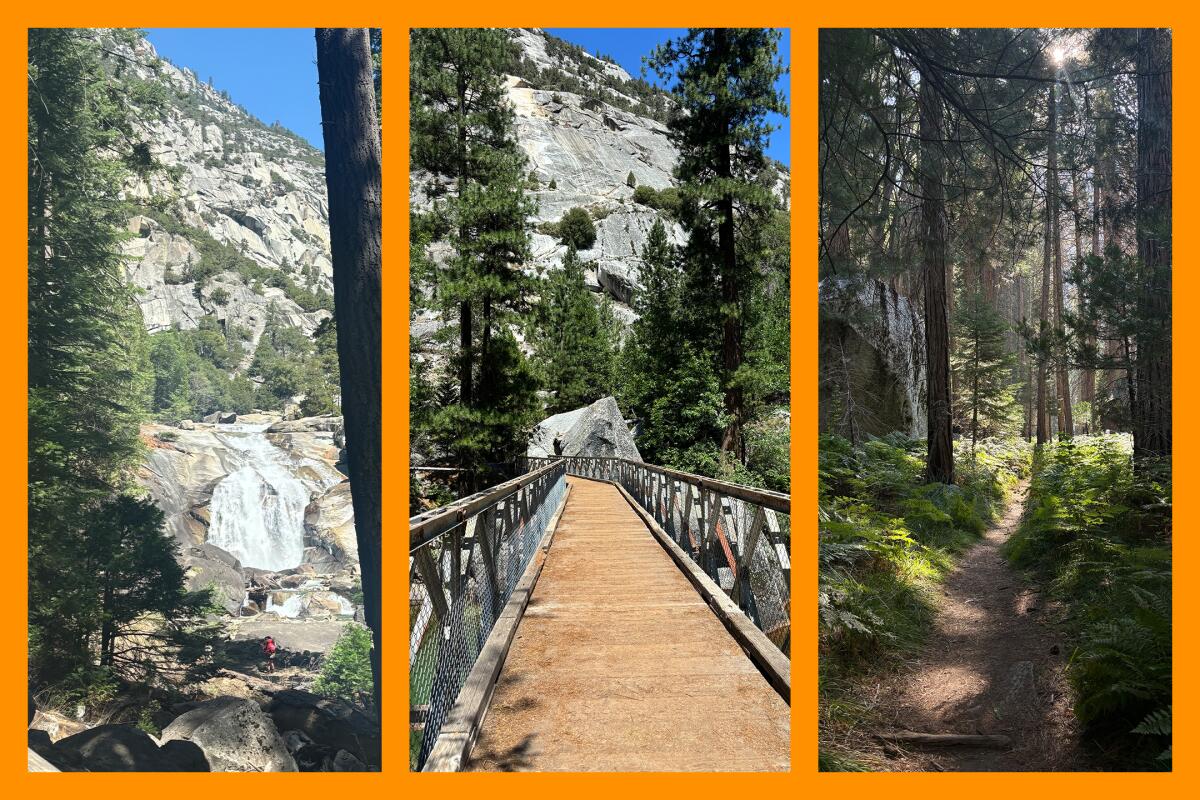
Mist Falls in Kings Canyon National Park; a Bailey bridge allows visitors to cross over the South Fork of the Kings River near the Mist Falls trail; the Mist Falls hike passes through forest where the ground is covered in ferns.
(Jaclyn Cosgrove / Los Angeles Times)
1. Mist Falls
If you do exactly one hike while in Kings Canyon, the Mist Trail must be it. This dynamic eight-mile out-and-back trek involves walking through forest, wetlands and finally up large boulders to a waterfall. It’s best in the summer to start this trail before 8 a.m.
You will park at the aptly named Road’s End (the road you take to get there is as far as any road can take you). Most of the park is only reachable by foot.
Before leaving, make sure all of your food and scented items — toothpaste, lip balm and other toiletries — are stowed in a bear box at the trailhead. Do not leave them in your car, as bears have been known to break into vehicles in the park.
The trail starts near the permit station (pictured here), where a ranger is available from 7 a.m. to 3:30 p.m. to answer any questions you might have. Inside the station, you can read up on trail conditions.
You’ll cross over a short bridge and enter a wide sandy path with some shade from pine, oak and other trees. This is the South Fork canyon, created by glaciers eons ago. I was in such awe of the granitic cliffs’ beauty, I found myself gaping at them — until a bug flew straight into my mouth.
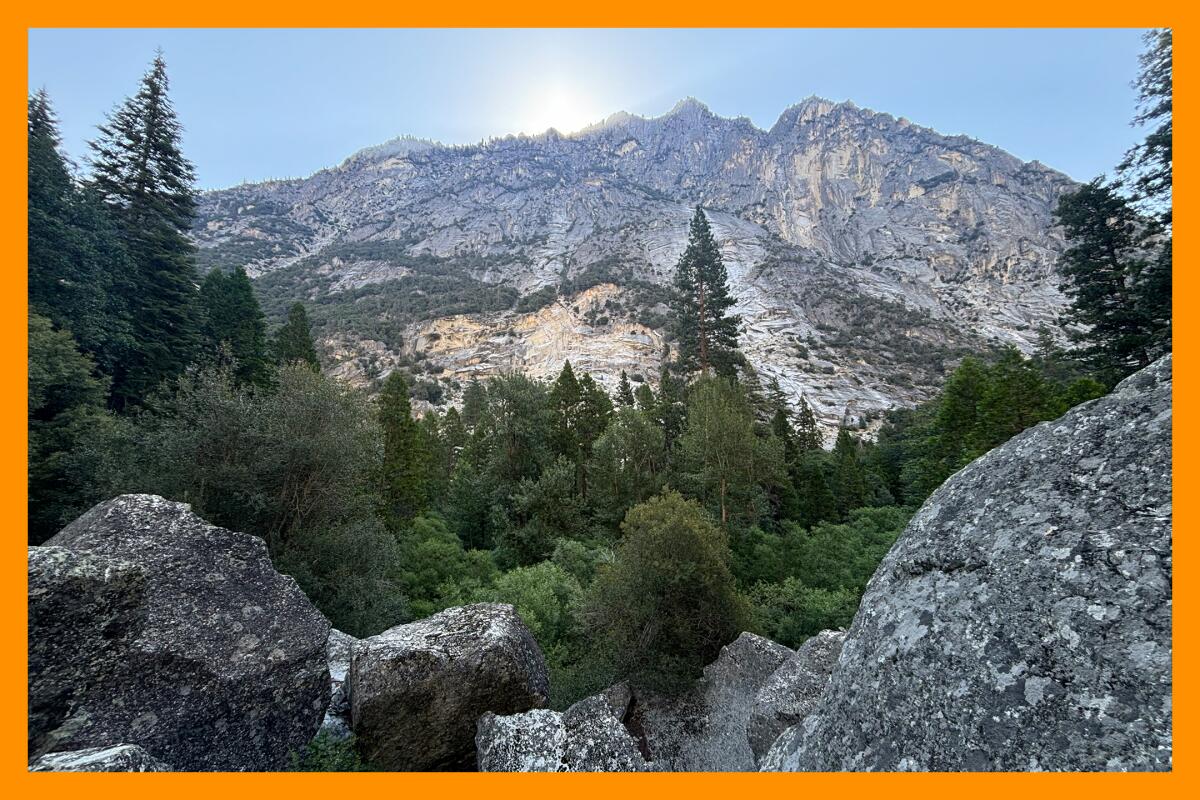
A view of canyon walls from the Mist Falls hike.
(Jaclyn Cosgrove / Los Angeles Times)
Which brings us to the one downside to this trail: It’s buggy if there’s no breeze. Despite using 20% DEET lotion, bugs swarmed my face for most of the hike. I decided to just clap a lot, both to hopefully smash some of them, and to alert bears and other creatures that I was nearby. Sometimes, I even struck up a rhythm.
This hike offers some nice tactile experiences. I paused a few times to grace soft fern fronds and craggy Ponderosa pine trees’ bark. Along with a variety of lizards, I noticed several California sister butterflies, some flying right by me, and heard the squeaky song of the brown creeper songbird. Although this corner of the park doesn’t feature sequoias, you will see hulking pine trees on this hike, tall enough to block out the sun as the day wears on.
(As you’re tuning into your surroundings, be mindful of where you step. I walked over a small hill on the trail to be greeted on the other side by the sound of a rattlesnake vibrating its tail at me. Luckily, thanks to a recent conversation with local herpetologist Earyn McGee, I knew exactly what to do when I saw it.)
About two miles in, you’ll notice a Bailey bridge. It’s slightly off trail but, a nice spot to take photos of the river, and adds only a few extra steps to your trek.
Back on the Mist Trail, you’ll pass through forests of towering ponderosa pines and other trees, a wetland where you can spot a fish or two, and finally, the ascent. Most of the path is pleasantly flat. Then, in the very last mile, you gain 600 feet in elevation. But buddy, it’s worth it.
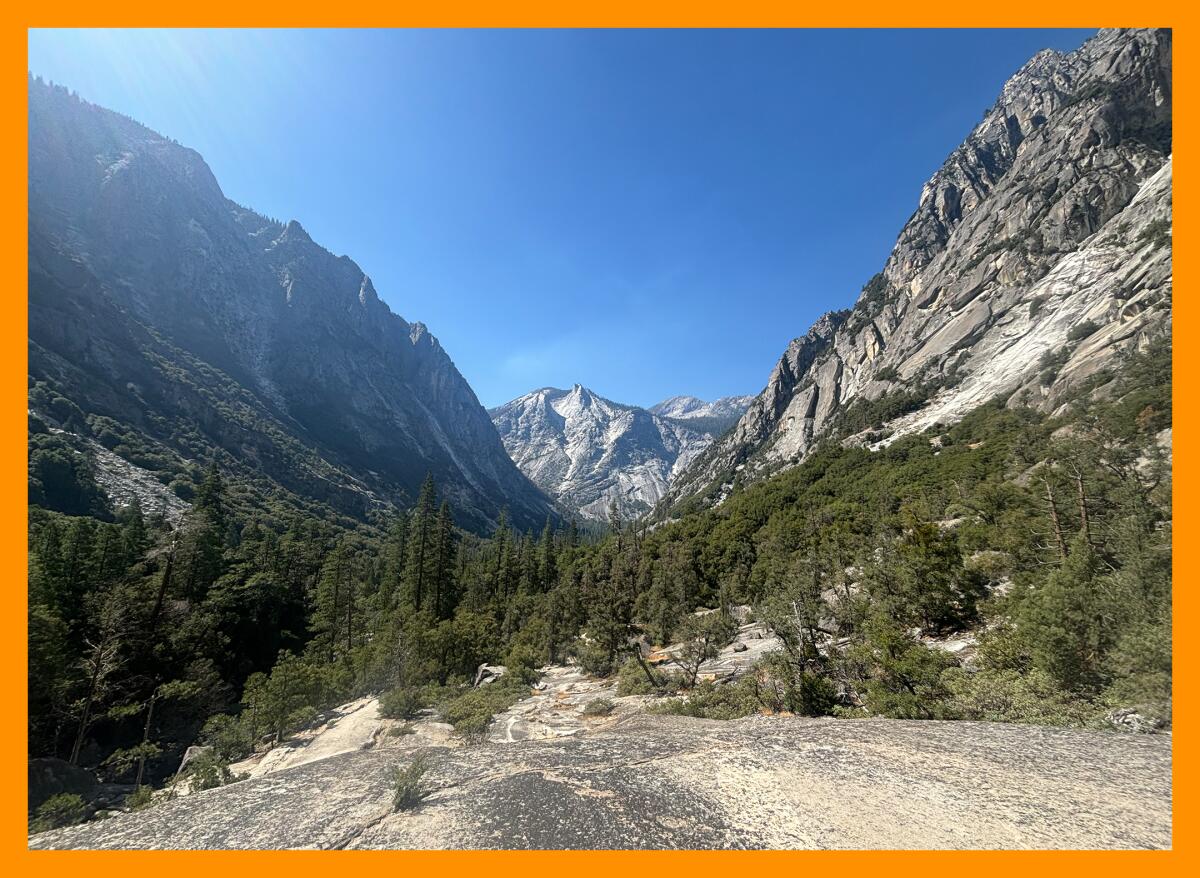
The view once you start to gain elevation on the Mist Falls trail in Kings Canyon National Park.
(Jaclyn Cosgrove / Los Angeles Times)
This final stretch is the most exposed: you’ll walk up rock steps and over massive boulders. Don’t forget to glimpse behind you as you ascend. There’s an awe-inspiring sweeping view of the canyon in all its glory. This section of the trek is ideal for catching your breath and snapping a few selfies. Look along the sides of the trail — being mindful not to get too close, as the rock near rivers is often slick — and you’ll see water cascade down boulders into emerald pools. Keep going, as none of these smaller waterfalls, albeit grand, are the big daddy of the park.
You’ll know when you’ve reach Mist Falls. It’s one of the largest waterfalls in the parks, seemingly as wide as it is tall. It also happens to be an excellent spot for lunch. Though, be wary of getting too close to the waterfall. I watched a few hikers climb onto rocks nearest to the falls, which are wet and slick. It’s not worth the photo. The river below is swift and, as signage throughout Kings Canyon asserts, drownings are the most common way people die in national parks.
The trail generally takes four to five hours to complete. I dillydallied, and I’d recommend you do the same. If you’re in the mood for an icy river swim after the journey, take a short walk from Road’s End to Muir Rock. Your muscles will thank you.
Trail type: Out and back
Length: 8 miles
Difficulty: Moderate
Elevation gain: 875 feet
Estimated time to finish: Four to five hours
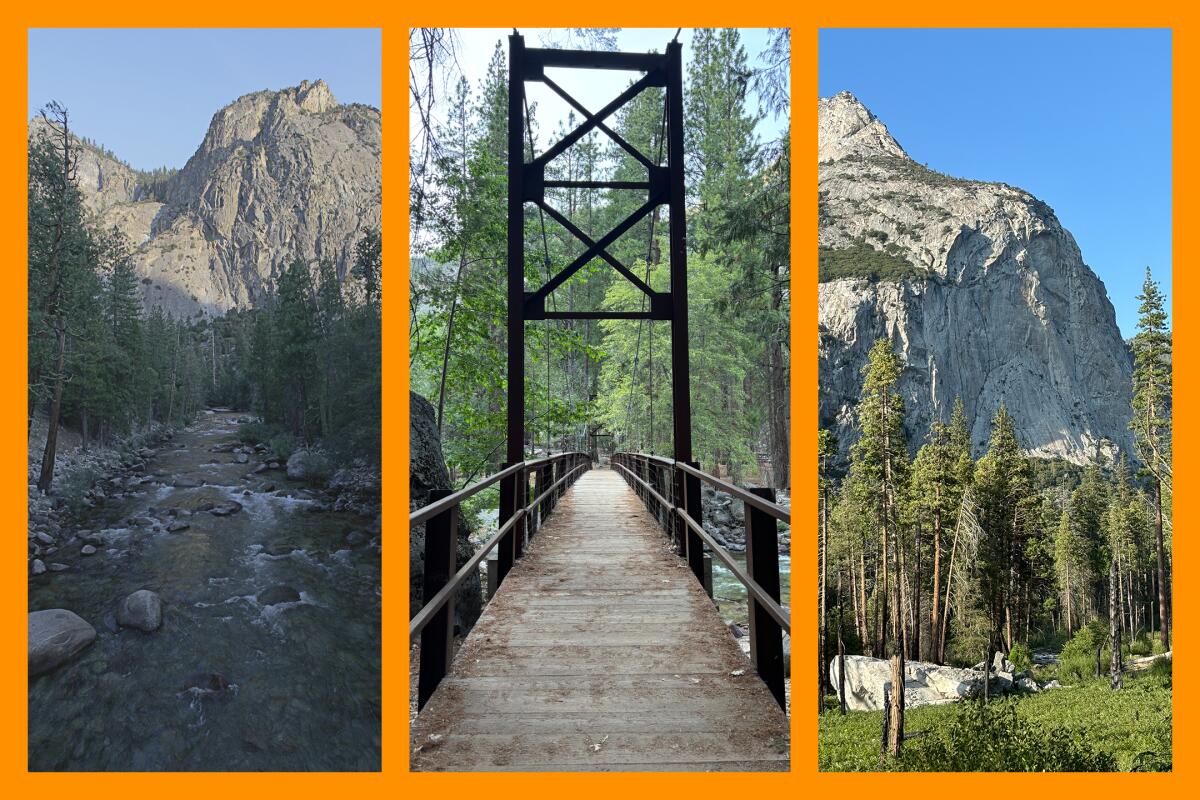
The South Fork of the Kings River runs alongside the trail near Zumwalt Meadows, a path that offers great views of the massive canyon walls; a suspension bridge crosses over the South Fork of the Kings Canyon in Kings Canyon National Park; the massive canyon walls near Zumwalt Meadows.
(Jaclyn Cosgrove / Los Angeles Times)
2. Roaring River Falls to Zumwalt Meadows
Just over four miles out and back, this trail is a low-effort, high-reward stroll where you can appreciate the magnitude of the canyon walls that rise thousands of feet high, taking up the sky view all around you. You’ll walk nearby these jagged cliffs, carved by glaciers and the Kings River, whose South Fork runs parallel with the trail, shaded by tall pines and other trees.
The trek begins with a short, paved path to the Roaring River Falls, yet another wet, booming natural wonder that lives up to its name. From there, turn onto a rocky path to Zumwalt Meadows. (Referred to as the River Trail on the maps the park provides.)
Although you see them on the drive in, viewing the behemoth rock canyon walls on foot really puts into perspective how big they are (and how small you are). It’s called Kings Canyon for a reason! These incredible cliff faces are gray, green and maybe even shades of blue, especially around sunset, when I took this trek.
The trail meanders parallel to the road before turning a bit deeper into the woods, nearer to the canyon wall, where you’ll crunch over pine needles and alongside ferns.
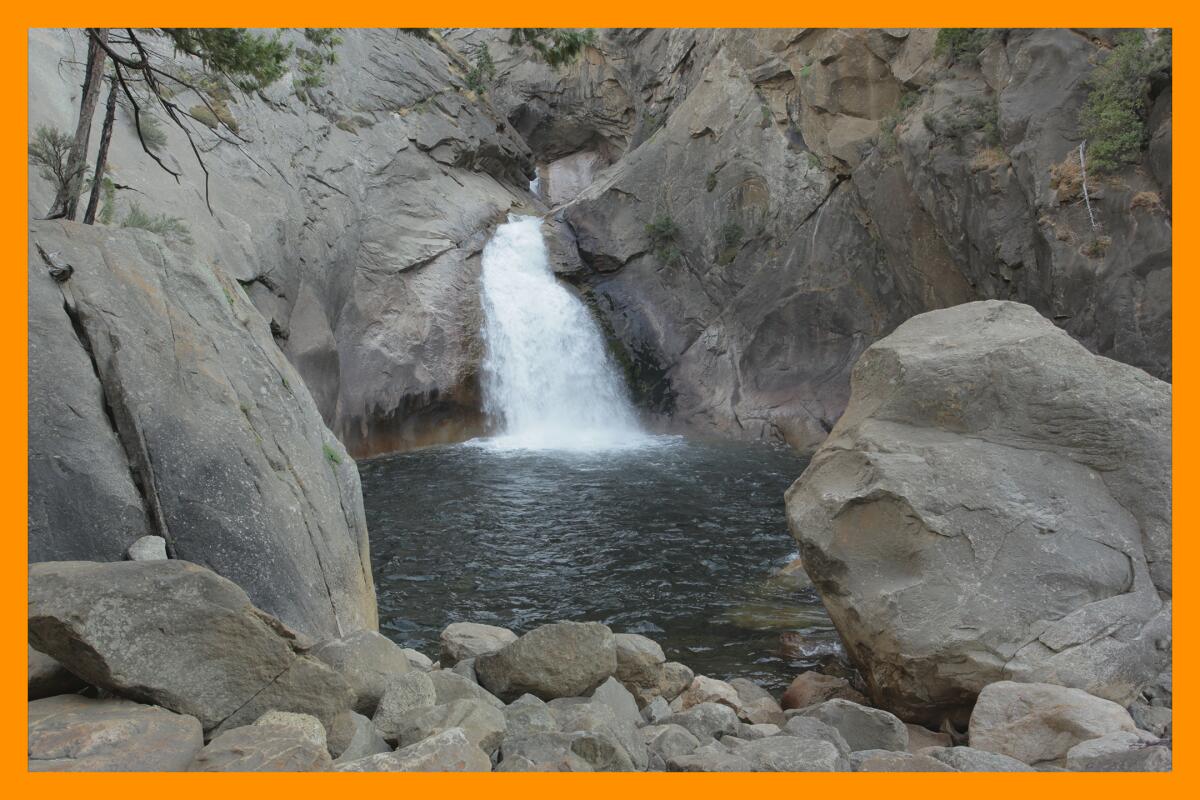
Roaring River Falls in Kings Canyon National Park.
(Jaclyn Cosgrove / Los Angeles Times)
You know how, when you relax on the beach, you can appreciate the singular sound of waves crashing? On this trail, you can focus on just the meditative rushing whoosh of the river. This is nature’s white noise machine.
About two miles in, you’ll find a suspension bridge and a closed path to Zumwalt Meadows. Flooding in 2019 destroyed the boardwalk that passes through the iconic meadow. I still recommend the trail because it’s a pleasant shaded walk. Plus, there are multiple sandy beaches and swimming holes, although you should be mindful of the current, as it is often strong.
I hiked this trail in the evening in early August, and saw only two people after the falls. I’ll admit: It felt a little apocalyptic, and I did briefly creep myself out. But for most of my trek, I felt really grateful to be unwinding in such peaceful solitude.
When it comes to deciding when to turn around, it’s a choose-your-own adventure. I did so at the Zumwalt Meadow loop closure, but you have the option to continue to Road’s End. I always take a photo of the map at the trail head so that, if I do decide to extend my adventure, I have an idea of where I’m going.
Trail type: Out and back
Length: 4ish miles, with an option to extend your journey
Difficulty: Easy
Elevation gain: 360 feet
Estimated time to finish: About two hours
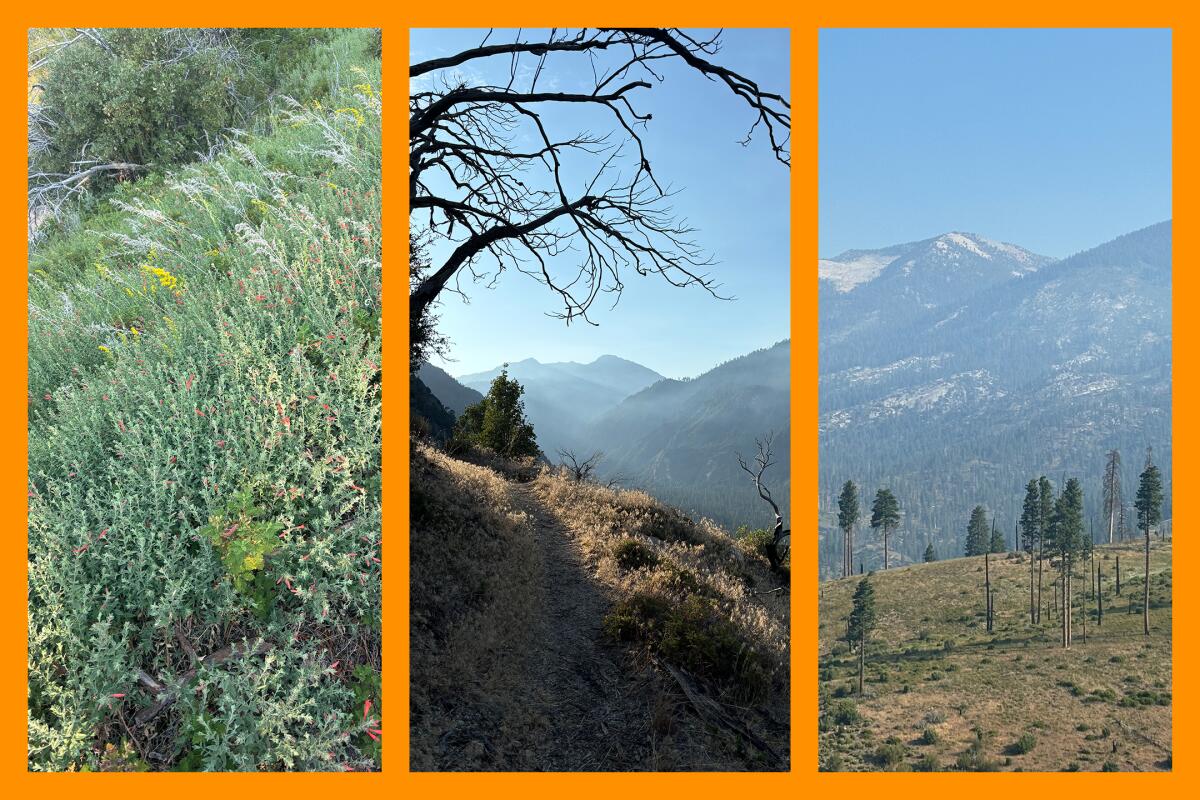
Wildflowers bloom on the Hotel Creek trail where a creek gently passes over the path; there’s minimal shade on the Hotel Creek trail, so it’s best to hike it early for sunrise or later for sunset; a view of the mountains you could reach, were you planning to extend your trip.
(Jaclyn Cosgrove / Los Angeles Times)
3. Hotel Creek Trail to Cedar Grove Overlook
This was one of my favorite hiking experiences ever. Is it because there was no one else on the trail for the majority of the trek? Sure. But more than that, it was the breathtaking views of the park’s cliffs and mountain peaks. From now on, when I imagine my “happy place,” it will be the overlook at the top of this trail.
Expect panoramic views and an overwhelming feeling of gratitude.
You will park about a half mile north of the Cedar Grove Lodge. As previously mentioned, leave everything a bear could possibly want (including anything scented from your bathroom bag) in the bear box provided at the trail head.
You have two main options for a day hike. You can hike 4.4 miles out and back to the Cedar Grove Overlook (which I did), or you can extend your trek so that it’s a loop with the Lewis Creek trail. A ranger told me that this is a great hike, regardless of which one you do. Sunrise is the best time to do it.
Shortly after you start, you’ll come alongside a creek. Pro tip: consider dipping your bandanna or hat in the running water so that you can stay cool in the heat.
Because next up are the trail’s many switchbacks. Remember, this is bear country. (I spotted fresh scat early on). The area is also home to deer, one of whom I greeted before she bounced up the mountain. The trail is thick with red-barked manzanitas and other plants, so consider wearing long pants to avoid scratches.
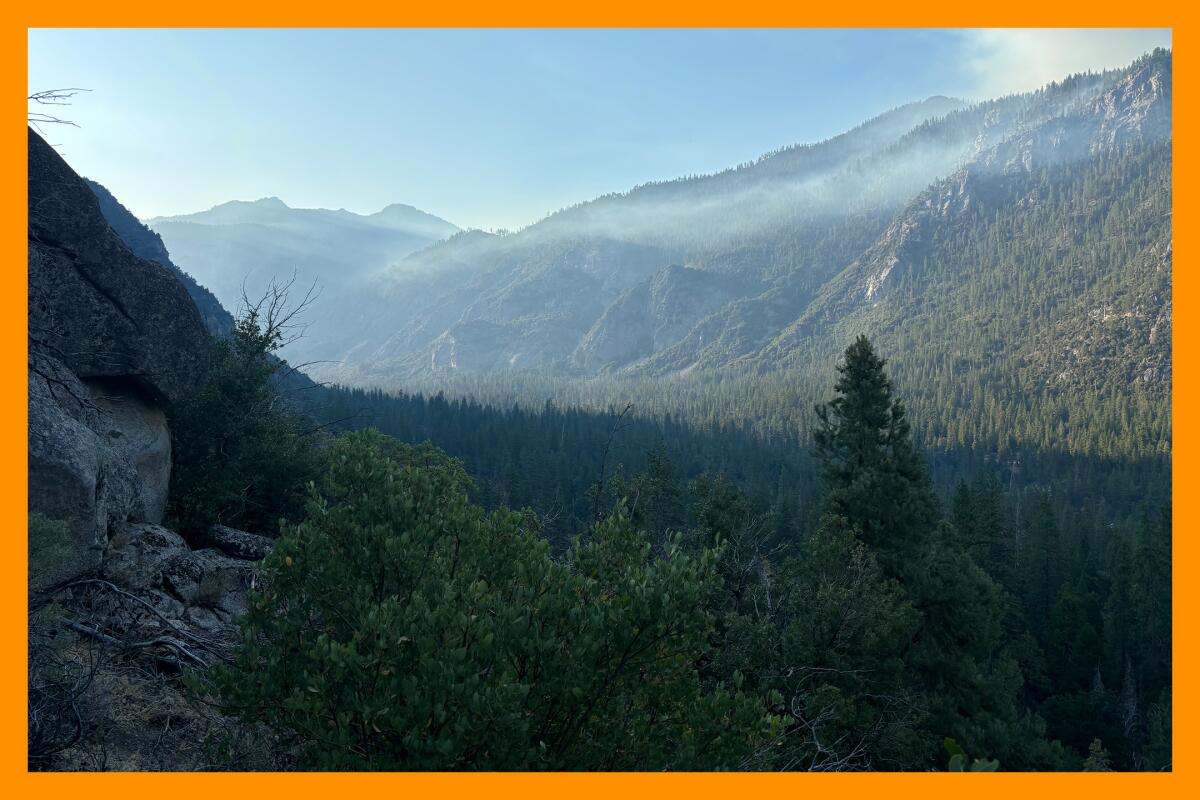
The view as you start to ascend the Hotel Creek trail.
(Jaclyn Cosgrove / Los Angeles Times)
The first thing you’ll notice in the valley below is the Cedar Grove Pack Station, where you might spot (or hear) horses and mules.
When I took the trail in early August, I noticed thin plumes of smoke from burning trees from the Sentinel Fire. It felt bizarre to hike so close, as the crow flies, to a wildfire, but I’d already read a park sign that said it posed no threat to public safety. As climate change worsens, this might be a new reality for hiking in California.
Once you reach the turnoff for the overlook, you’ll find a narrow trail bursting with plants on both sides and a few downed trees. (Some would call it “overgrown,” but this isn’t Disneyland, folks.)
The lookout is about 6,090 feet in elevation, allowing you to see beyond the canyon walls to even more spectacular views. When I got there I sat on a boulder, trying to count the peaks in the panoramic view. I lost count at 20.
To the north, you’ll spot glaciated granite peaks, including Kennedy Mountain and Hogback Peak, a view that reminded me of the very rocky Mt. Baldy. The river, Highway 180 and Cedar Grove area, including the Sentinel Campground where I stayed, is to your south.
I got back to my car with a new adventure on my bucket list. Next time, I want to look at the Cedar Grove outlook from those peaks.
Trail type: Out and back
Length: 4.4 miles with an option to extend your journey to a 6.9-mile loop
Difficulty: Moderately challenging
Elevation gain: About 1,600 feet
Estimated time to finish: About three hours

3 things to do
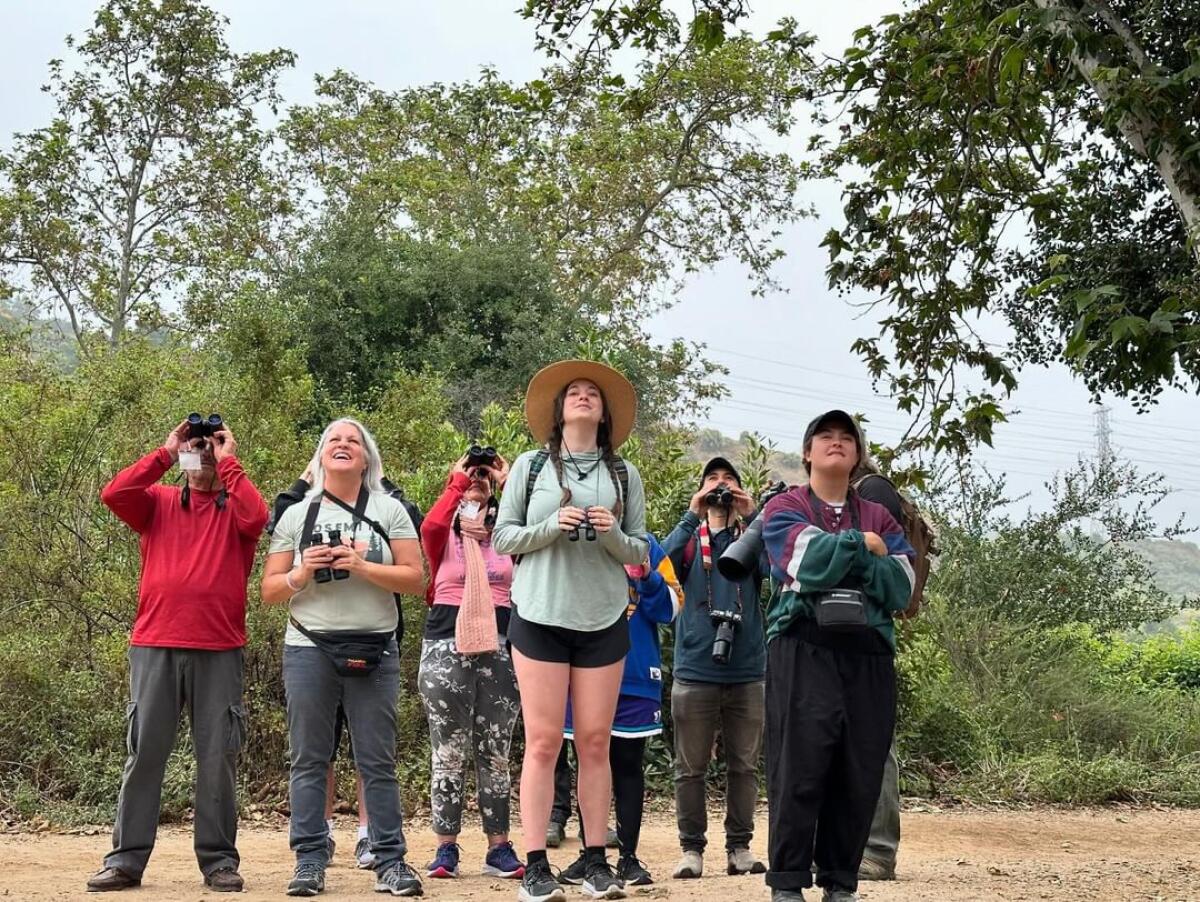
Birders enjoy a hike through Eaton Canyon led by the Pasadena Audubon Society.
(Kristin Ochoa)
1. Go birding in the evening at Eaton Canyon
Have you ever listened closely enough to nature to notice the daytime birds quieten down and the owls start to hoot? You’ll have a chance to on a hike with the Pasadena Audubon Society and Eaton Canyon Nature Center volunteers from 6:30 to 8:45 p.m. next Thursday, Sept. 5. Sturdy shoes are recommended for this 2.5-mile intermediate hike, which will include water crossings. Participants should also bring water, an extra layer, a flashlight and binoculars. Beginning birders are welcome. An Audubon Society membership is not required. The event is limited to 30 people, chosen by lottery. The signup deadline is 6 p.m. Sunday. Sign up at pasadenaaudubon.org.
2. Watch an episode of “M*A*S*H” where it was filmed in Calabasas
Actor Jeff Maxwell, who played Pvt. Igor Straminsky in the hit TV series “M*A*S*H,” will join the 7 p.m. gathering this Saturday at Malibu Creek State Park to share stories about his time filming there. Afterward, guests will watch an episode of the war dramedy. The event, part of the Campfire Program, is free. Only in L.A., friends. No reservations are required. Learn more at malibucreekstatepark.org.
3. Advocate for your community park’s needs in L.A. County
Throughout September, L.A County Parks will host community meetings at 67 parks and nature centers where the agency will seek input on how it should spend next year’s budget. The meetings are also an opportunity to learn about programs at your parks and meet local staff. Childcare and translation services will be available at some meetings. Learn more at parks.lacounty.gov.

The must-read
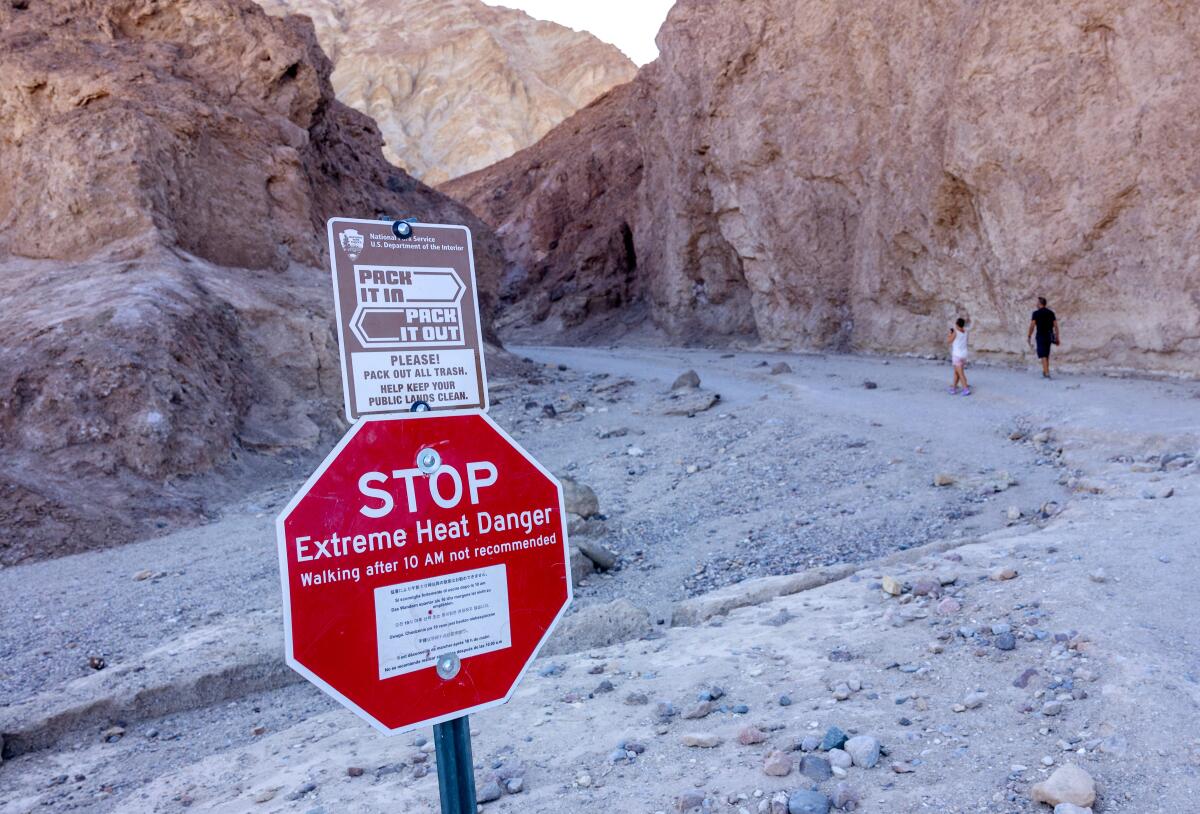
Hikers heading out on an early morning hike in Death Valley National Park’s Golden Canyon pass a sign warning against using the trail after 10 a.m. when temperatures become dangerously high.
(Brian van der Brug/Los Angeles Times)
An increasing number of people are dying from heat, a study published Monday in medical journal JAMA found. Times writer Hayley Smith reports that there’s been a surge in heat-related deaths in the past seven years — including at least 2,325 deaths in 2023, our planet’s hottest year on record. Heat deaths are often undercounted, in part because heat isn’t consistently listed as the cause of death in coroner records. What’s to be done? Public officials, including Gov. Gavin Newsom, say they’re taking action against extreme heat, but “heat-related programs took a hit amid this year’s state budget cuts, including notable slashes to the extreme heat action plan and reductions from urban greening programs,” Smith wrote.
L.A. is currently in the time of year when our forecast flip-flops from pleasant to oppressive until finally, we look up and realize it is fall. Until then, please stay safe out there. If you think you’ve packed enough water, perhaps throw another bottle into your bag.
Happy adventuring,

P.S.
Next Saturday is the annual California Biodiversity Day. There are several outdoor events that day and week throughout L.A. County, including hikes, data collection projects, cultural events and more. Enjoy!
Also: Today is my 9th wedding anniversary. I’d like to wish my wife, Tiffany, a happy anniversary. In 2015, we spent our honeymoon in Banff National Park. Not only was it safe to be openly queer there, but also home to some of the most spectacular sights in the world, including the Plain of Six Glaciers Teahouse, the Athabasca Glacier and the Kicking Horse River. It’s not a very far plane ride, consider a visit!
For more insider tips on Southern California’s beaches, trails and parks, check out past editions of The Wild. And to view this newsletter in your browser, click here.
